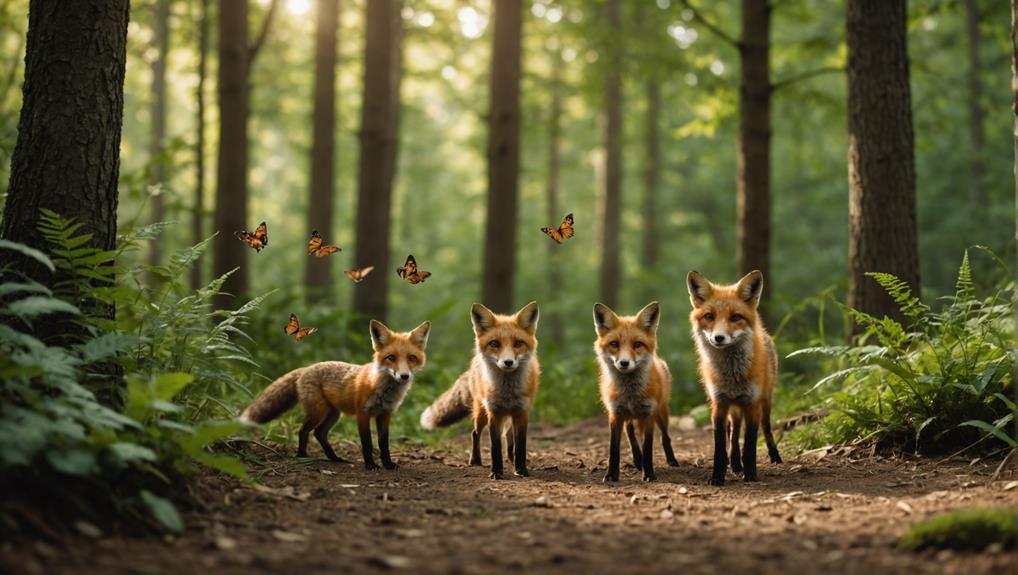Fox families are like tiny, furry communities where everyone pitches in. You've got the dominant pair leading the pack, while the little ones stick around to learn hunting skills and help raise their siblings. Each fox has unique roles, from the playful kits who practice their skills to the adults who cooperate in parenting, making sure dinner gets served. Communication is key, with a mix of sounds and body language that keeps them connected. As conditions change, they adapt their social dynamics to thrive. Curious about how these clever critters balance fun and survival? There's plenty more to explore!
Contents
- 1 Understanding Fox Social Hierarchy
- 2 Mating and Partnership Bonds
- 3 Rearing and Protecting Offspring
- 4 Territorial Instincts and Boundaries
- 5 Communication and Interaction
- 6 Survival Tactics in the Wild
- 7 Adaptation and Evolution of Family Roles
- 8 Social Dynamics Within Family Units
- 9 Parental Roles in Kit Development
- 10 Impact of Environment on Behavior
- 11 Final Thoughts
Understanding Fox Social Hierarchy
When you immerse yourself in understanding fox social hierarchy, you'll find that it revolves around a dominant male and female pair that lead the family group. This dynamic duo isn't just for show; they play a significant role in the survival of the fox family, particularly when it comes to hunting and foraging for food, which is essential for their survival in diverse habitats like a variety of environments.
They communicate through a mix of vocalizations and body language, ensuring everyone knows their place and responsibilities.
The offspring often stick around for up to 18 months, helping their parents rear future litters. Imagine a bustling household, where everyone pitches in, just like a team working toward a common goal.
The hierarchy also affects how they hunt and forage, with the dominant pair usually taking the lead in these important activities. Strong social bonds within the family help improve cooperation, making them more successful at parenting and survival.
Mating and Partnership Bonds
When it comes to mating and partnership bonds in fox families, there's a lot more than just a cute romance.
You'll find that red foxes often form lasting monogamous pairs, working together to raise their kits like a well-oiled team.
These partnerships are essential for the survival of their young, as they share responsibilities in hunting and protecting their territory.
From courtship rituals that might involve playful chases to the male regurgitating food for his little ones, these foxes show us that love and parenting can be a real partnership! notable fox behaviors
Mating Rituals and Courtship
In the enchanting world of red foxes, mating rituals and courtship play a crucial role in forming strong partnership bonds. You'll find that these clever creatures typically form monogamous pairs during the breeding season, which creates lasting connections. The dominant female takes the lead in initiating mating, and she's quite discerning; she looks for a mate who can provide food and protection during this vulnerable time.
Notably, similar to Arctic foxes, their mating habits are essential for ensuring the survival of their young, as both parents are involved in rearing the kits, providing them with the necessary skills to thrive in their environment, especially in harsh conditions like those faced by their Arctic relatives key adaptations for survival.
As you observe, courtship behaviors are quite charming. You'll see playful interactions, hear delightful vocalizations, and witness mutual grooming, all of which help strengthen the emotional ties between partners. It's like a little fox love story unfolding right before your eyes!
These mating rituals often involve elaborate displays of affection, showcasing the social intelligence of these furry friends. After about 52 days of anticipation, the female will give birth to a litter of kits, and both parents jump into action to rear and protect them.
Parental Care Responsibilities
Parental care responsibilities in red fox families highlight the intricate dynamics of mating and partnership bonds. When it comes to raising their young, the male red fox really steps up. He provides food and care for the mother and her kits during the critical nursing period, which lasts about 4 to 5 weeks. It's like having a supportive partner who's always got your back!
The dominant female takes charge of birthing the kits, while other family members jump in to help with their upbringing. This cooperative breeding strategy shows just how important teamwork is in the fox family. Strong pair bonds form between mating partners, and you can often catch them grooming and playing together, reinforcing their relationship.
Interestingly, both parents also take on disciplinary roles. Dads, in particular, might correct overly energetic kits, teaching them valuable lessons about boundaries and how to survive in the wild.
These bonds last well beyond just one litter, as older siblings often stay around to help raise the next generation. So, in red fox families, it's all about love, support, and a shared commitment to nurturing the little ones!
Rearing and Protecting Offspring
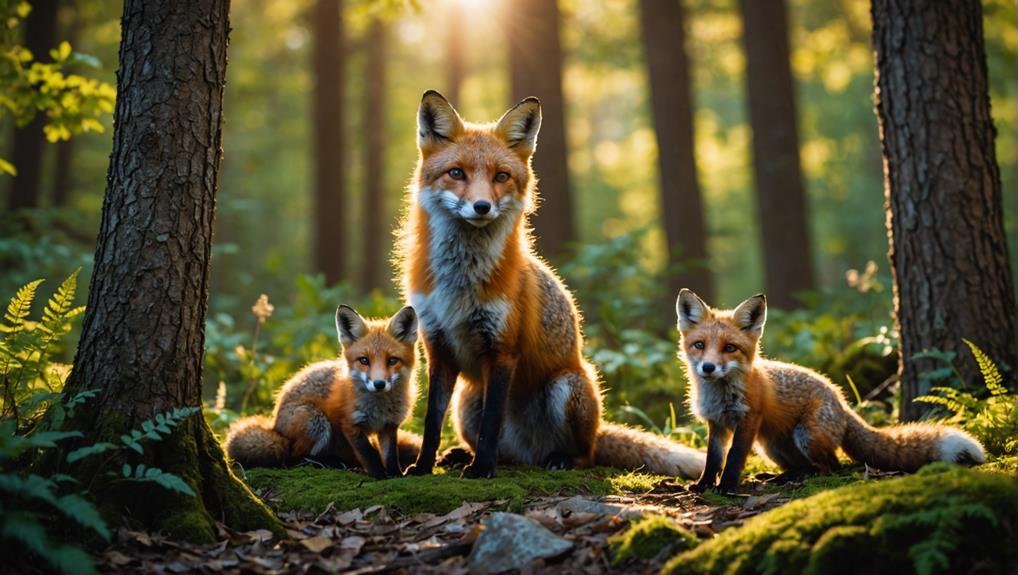
Raising and protecting young kits is an essential responsibility for red fox families, as the dominant female gives birth to a litter after a gestation period of about 52 days. The average kit weighs around 100 grams at birth—tiny, but oh so full of potential!
In those early weeks, the mother primarily nurses the kits, while the father steps up by providing food and keeping a watchful eye for any threats. It's a true team effort!
Fathers don't just provide food; they're often found grooming and caring for their little ones, which helps strengthen those family ties.
Watching kits play is a joy, as they learn fundamental survival skills through these playful antics that resemble hunting techniques. It's like their own version of a training camp!
Typically, these kits stay with their family for about 10 to 18 months, helping with future litters and boosting the family's cooperative efforts in foraging and protection.
It's heartwarming to see how they grow together, learning and serving one another. So, next time you spot a fox family, remember the love and teamwork that goes into rearing those adorable kits!
Territorial Instincts and Boundaries
Fox families aren't just focused on nurturing their young; they also have a strong instinct to establish and defend their territory. These clever creatures use scent marking to communicate their boundaries, ensuring other foxes know where they stand. Think of it as the fox version of putting up a "no trespassing" sign!
The size of a fox's territory can vary widely, ranging from 1 to 12 square miles, depending on how much food and resources are available.
When it comes to asserting their rights, foxes rely on vocalizations and body language, especially during the breeding season. You might hear some interesting sounds as they let others know who's boss!
But be warned, territorial disputes can get pretty heated. When times are tough and resources are scarce, a little competition can lead to aggressive encounters.
Dominant foxes tend to maintain larger territories, which gives them better access to food and potential mates.
Communication and Interaction
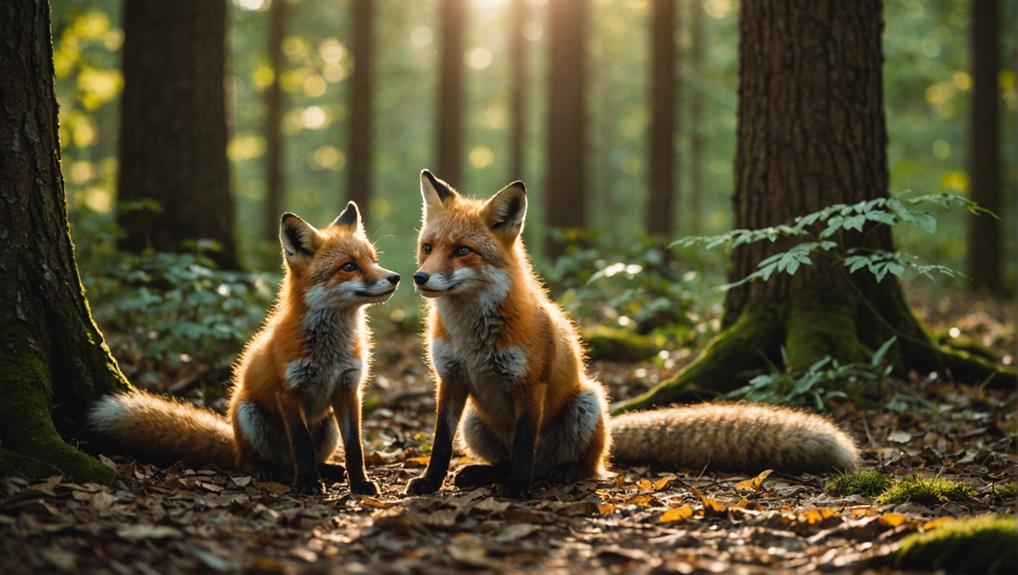
When you think about fox families, their chatter and body language really tell a story of connection.
With over 20 different sounds, like playful gekkers and warning barks, they communicate more than just words; they express excitement and establish their place in the family hierarchy.
It's pretty heartwarming to see how these clever creatures work together, whether they're sharing food with their kits or coordinating a hunt, showing us that teamwork is key in their little world.
Vocal Communication Methods
How do foxes convey their emotions and intentions? These clever creatures use vocal communication methods that are as diverse as their personalities. With over 20 distinct calls, you'd be amazed at how they express everything from warning signals to playful barks.
For instance, the gekker call pops up during fun moments, but it also serves as a way for mothers to communicate with their kits, showcasing their nurturing side.
Foxes aren't just chatting for fun; they're smart critters. Their vocalizations strengthen family bonds and help coordinate hunting activities. You can imagine a family of foxes, each using specific calls to alert one another about dangers lurking nearby or to signal it's time to gather for dinner.
It's like a family meeting, but with more tail-wagging! The sounds vary greatly depending on the situation. Whether it's a chilling scream to warn of danger or baby-like cries to call their young, these vocalizations reveal their intricate social structure.
Family Interaction Patterns
Engaging in a rich tapestry of communication, red foxes showcase intricate family interaction patterns that deepen their social bonds. These clever creatures use a vocal repertoire of over 20 distinct calls, from playful gekker sounds to urgent warning barks.
Imagine a family dinner where everyone's sharing their thoughts and feelings—this is how foxes connect!
The strong pair bonds between male and female foxes play a huge role in raising their kits. You'll find the dad often regurgitating food for the little ones, which is a pretty sweet way to show love. Meanwhile, kits learn essential survival skills through play, mimicking their parents and siblings, just like kids do at home.
In their family, adult foxes establish a hierarchy, using body language and vocalizations to keep things running smoothly. It's like a family meeting without the awkward silences!
These interactions create a nurturing environment where cooperation thrives, and each family member knows their role. By understanding these patterns, you can appreciate the depth of the fox family dynamic.
Survival Tactics in the Wild
Survival in the wild demands cunning and teamwork, especially for red fox families. These clever creatures rely on their strong social bonds to guarantee their young thrive. The dominant pair leads the way, coordinating survival tactics while teaching their kits essential skills. You'll often see the little ones engaging in playful mock hunts, learning to stalk and pounce—perfecting their hunting techniques for the future.
Adult red foxes are true opportunists. They forage and scavenge, adapting to whatever food sources are available, even in bustling urban areas. Isn't it amazing how they make the most of their environment?
However, life can be tough. With an average litter size of about six kits, only three might survive harsh conditions, reminding us just how challenging their world can be.
Parental roles are significant, too. The father fox is often the provider, bringing home food while staying alert for threats. Meanwhile, the mother fox nurtures and instructs her young, making sure they're prepared for what lies ahead.
Together, they create a warm and supportive environment, proving that teamwork is the heart of survival for red fox families.
Adaptation and Evolution of Family Roles
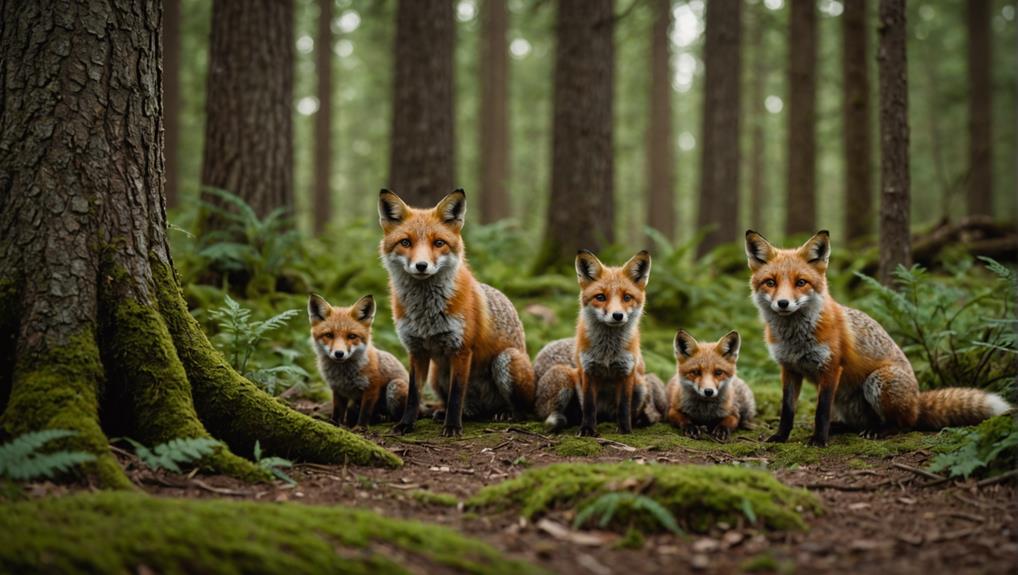
The intricate family dynamics of red foxes highlight remarkable adaptations that enhance their survival.
In a red fox family, you'll see how the dominant female usually bears the litters, while other family members jump in to help rear the young ones. It's like a team effort, showcasing cooperative breeding behavior that's pretty unique!
During the breeding season, strong pair bonds form, boosting reproductive success. This shared parental investment means the kits have a better chance of thriving. As the little ones grow, they learn essential life skills by watching, playing, and engaging with their parents—like a furry version of YouTube tutorials!
What's even more fascinating is how flexible family roles are. In changing environments, red foxes adapt to new conditions, thriving even in urban settings.
Family members work together, sharing resources and cooperating in hunting, ensuring that everyone has enough to eat. This teamwork not only supports the kits during their vital developmental phases but also strengthens their bonds.
Social Dynamics Within Family Units
In the world of fox families, parental care is a team effort, with mom nursing the kits while dad brings home the bacon—figuratively speaking, of course!
You'll find that sibling interactions are just as essential, filled with playful tussles and learning moments that shape their future hunting skills.
It's a busy life, but that mix of responsibility and fun makes for a tight-knit family that truly knows how to work together and enjoy each other's company.
Parental Care Responsibilities
Nurturing their young, red fox families showcase a remarkable division of parental care responsibilities. In these loving families, the dominant female takes on the vital job of nursing and caring for the kits during their early weeks. She guarantees they get the essential nutrients they need to grow strong.
Meanwhile, the male fox steps up by delivering food to both the mother and the kits, keeping everyone well-fed and happy.
But that's not all! Both parents engage in grooming behaviors, licking and cleaning the kits to promote hygiene and strengthen their social bonds. It's like a furry spa day!
The father fox also keeps a watchful eye on the surroundings, protecting his family from any potential threats. You could say he's the designated bodyguard of the fox world.
As the kits grow, they learn important survival skills through playful interactions with both parents. Those silly mock stalking games? They're not just for fun; they're vital for developing hunting techniques.
Sibling Interaction and Play
Engaging in playful antics, fox kits plunge into a world of fun that's essential for their development. As they tumble and chase each other, these little explorers mimic hunting behaviors, honing skills they'll need for survival.
Watching them, you can't help but smile as they practice their mock stalking and pouncing, turning every leaf and twig into an adventure.
Sibling interactions often escalate into competitive games, which might seem fierce but actually strengthen their bonds. Through this play, kits learn to observe and imitate one another, enhancing their learning experiences in various scenarios.
It's like a wild, furry classroom where they master agility and strategy through laughter and friendly rivalry.
These playful exchanges aren't just about fun; they're significant for shaping family dynamics. As fox kits engage in their spirited antics, they refine their hunting techniques, preparing themselves for the real deal down the line.
It's a essential part of their early development, showcasing the importance of socialization.
Parental Roles in Kit Development
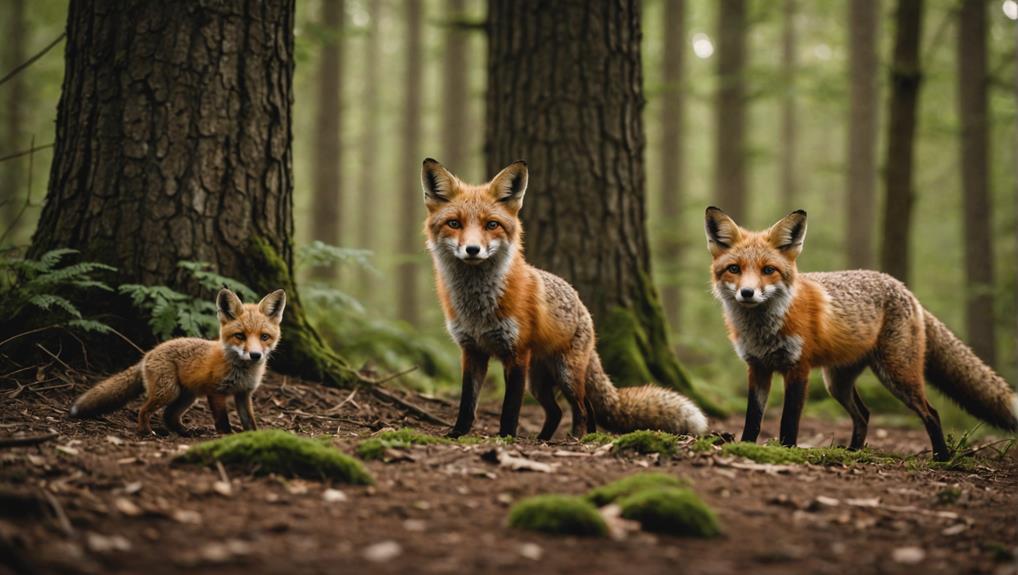
Throughout the early stages of a kit's life, parental roles are fundamental for their development and well-being. The father fox plays a significant part by providing constant care and grooming for his little ones, ensuring their red coats stay clean and comfy.
While the kits snuggle safely in the den, the mother fox focuses on nursing them for those essential first 4 to 5 weeks, giving them the crucial nutrition they need.
When the mother steps away, the father keeps a watchful eye, protecting the family from potential threats that could harm his precious kits. You can almost feel the excitement in the air when the parents return; the kits jump and squeal with joy, showcasing those strong family bonds.
But it's not all fun and games! The father also gently disciplines the overly exuberant kits, teaching them important lessons about behavior.
Together, these parental roles create a nurturing environment. It's like a cozy little fox family, where love, guidance, and protection help the kits thrive.
Impact of Environment on Behavior
How does the environment shape the behavior of red foxes? It's fascinating how these clever creatures adapt to their surroundings! Urbanization, for instance, has turned many red foxes into city slickers, as they hunt for small rodents and other food sources near human habitats. They've become quite the opportunists, don't you think?
Weather patterns also play a key role in their behavior. When conditions change, foxes adjust their activity levels to maximize their chances of catching prey. After all, nobody wants to miss out on a tasty meal of small mammals or birds!
However, competition with other predators like coyotes and domestic dogs can complicate things. Foxes often tweak their hunting strategies and social interactions to stay one step ahead.
Sadly, habitat destruction poses significant challenges. When their homes are fragmented, foxes face reduced prey availability and increased risks from road accidents. It's a tough life out there!
Final Thoughts
In the grand tapestry of fox family life, every role weaves together to create a vibrant picture of survival and connection. From the playful kits learning the ropes of their wild world to the watchful parents safeguarding their territory, each fox plays a part in this intricate dance. So next time you catch a glimpse of these clever creatures, remember, they're not just scavengers—they're a family, traversing life together, with love and a little mischief at every turn.

